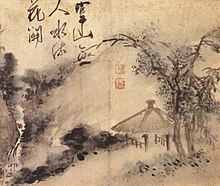Korean landscape painting
The Korean landscape painting had its origins in a Namjongwha ( 남종화 designated) Chinese Südschul painting and took place in Korea during the Goryeo -Periode (913-1392) feeder.
history
The term southern school painting can be traced back to the calligrapher , painter , art critic and statesman Dong Qichang ( Chinese 董其昌 , Pinyin Dǒng Qíchāng , W.-G. Tung Ch'i-ch'ang ; 1555–1636), who was all well-known painters at the time China assigned a northern and a southern school. To the northern school he counted all academically shaped painters and to the southern school, to which he also counted himself, he assigned all literary painters for whom their art was an activity at leisure and had a high priority. Dong based his assignment on the fact that the Chinese royal court mostly resided in Beijing and that the academic painters, especially those of the Zhe school, painted for the Chinese imperial court. From his point of view, the painters at the southern school were mostly highly talented “lay painters” who devoted themselves to landscape painting.
Goryeo period
Research has so far not been able to clarify when, in what form and by whom the landscape painting of the South School, which had a great influence in China, Korea and Japan, was introduced in Korea. What is certain, however, is that this happened during the Goryeo period ( 고려 ) (918–1392), as the Goryeos royal court had close cultural ties with the court of the Song Dynasty ( Chinese 宋朝 ) (960–1279) and the Yuan Dynasty ( Chinese 元朝 ) (1279–1368), where the styles of the southern school later predominated.
From the second half of the Goryeo period, close contacts to a circle of painters can be proven, to whom Zhao Mengfu ( Chinese 趙孟頫 ) (1254–1322), Zhu Derun ( Chinese 朱德润 ) (1294–1365) and Gao Kegong ( Chinese 高 克恭 ) (1248–1310) belonged. The first two Chinese painters mentioned are known to have frequented the court of Goryeo King Chungseon ( 충선왕 ) (1308–1313) and influenced calligraphy and painting in the period. A special influence is also attributed to Gao Kegong, whose painting style can be found in pictures by Ko Yong-hui ( 고용희 ) and whose works hang in the Konchiin Buddhist temple in Kyoto in Japan, although he himself is counted among the Korean painters.
Joseon period
In the early Joseon period, which is outlined with the period from 1392 to around 1550, the painting style of Gao Kegong, who named after the Chinese painter Mi Fu ( Chinese 米 芾 ) (1051–1107), was called the Mi-Fu painting style was further maintained. The painters Yi Chang-son ( 이장 손 ), Choe Suk-chang ( 崔叔昌 , 최숙창 ) and Seo Mun-bo ( 徐文 寶 , 서문 보 ) should be mentioned here, who were probably at the court of Joseon in the 2nd half of the 15th century were active.
In the middle Joseon period (1550–1700), which was influenced by the Korean Zhe school, the painting style characterized by Gao Kegong continued in landscape painting and found in the scholar Kim Si ( 金 禔 , 김시 ; 1524– 1593) a special expression by using softer and moister brush and ink techniques. The Korean painters of the 17th century included painters such as Yun Du-seo ( 尹 斗 緖 , 윤두서 ; 1668–1715) and Heo Yu ( 허유 ), who were inspired by the painting treatises of the Chinese master Gu Kaizhi ( Chinese 顾 恺 之 ) (344–405 ) were influenced.
Yun Du-seo , who can be assigned to the late Joseon period (1700-1850), dealt with Western culture, but also stuck to the traditional styles. Jeong Seon ( 정선 ) (1676–1757) was the representative of the southern school, but he wanted a natural reproduction in his pictures. Another painter of the late period was Kang Se-hwang ( 강세황 ) (1713–1791), who studied landscape painting in the Mi-Fu style and developed his own style of painting through Western influences.
The great masters of the last phase of the Joseon period (1850–1910) included painters such as Kim Cheong-heui ( 김청희 ) (1786–1857), Jo Hui-ryong ( 조희룡 ) (1797–1859), Cheon Ki ( 田 琦) , 전기 ; 1825–1864), Heo Ryeon ( 허련 ) (1809–1892), Kim Su-cheol ( 김수철 ) (19th century), Kim Chang-su ( 김창수 ) (19th century) and Jang Seung- eop ( 장승업 ) (1843-1897).
With the annexation of Korea in 1910 by the imperialist Japan of that time and the related cultural policy of the Japanese Empire , Korean painting came under the influence of Japanese thought and Japanese southern painting, known as Nanga .
literature
- Ahn Hwi-joon: The landscape painting of the South School in Korea . In: Kulturstiftung Ruhr Essen, Villa Hügel (ed.): Korea: The old kingdoms . Hirmer Verlag, Munich 1999, ISBN 3-7774-8220-X , p. 69-80 .
Individual evidence
- ↑ a b c Ahn: The landscape painting of the South School in Korea . 1999, p. 69 .
- ↑ a b Ahn: The landscape painting of the South School in Korea . 1999, p. 70 .
- ↑ Ahn: The landscape painting of the South School in Korea . 1999, p. 70 f .
- ↑ Ahn: The landscape painting of the South School in Korea . 1999, p. 71 .
- ↑ Ahn: The landscape painting of the South School in Korea . 1999, p. 72 .
- ↑ Ahn: The landscape painting of the South School in Korea . 1999, p. 74 .
- ↑ Ahn: The landscape painting of the South School in Korea . 1999, p. 75 .
- ↑ Ahn: The landscape painting of the South School in Korea . 1999, p. 78 .


